

OLYMPIC PENINSULAThe Pacific Coast Scenic Byway and two Legendary LodgesStory by Lynn Rosen, photos by Steve GiordanoHighOnAdventure.com December 1, 2010 |
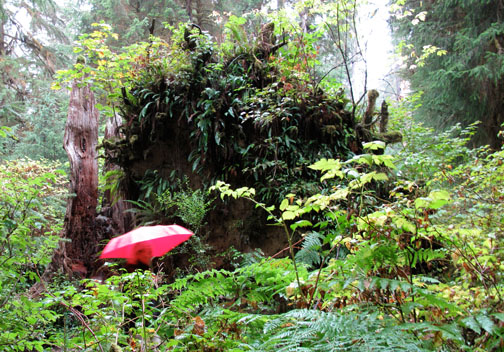 |
||
Olympic Peninsula—A walk in the Hoh Rain Forest |
We were so psyched. Got up early in the morning, packed our bags and the cooler full of goodies, climbed into the van and headed out for a three-day adventure driving the Pacific Coast Scenic Byway that circles the Washington State Olympic Peninsula. We had arranged to stay at two of the legendary Big Four lodges on the Olympic Peninsula; the Big Four being Lake Crescent Lodge, Sol Duc Hot Springs Resort, Kalaloch Lodge and Lake Quinault Lodge. Aramark, the company that manages these lodges has a number of special packages listed on this page: http://www.olympicnationalparks.com/specials.aspx. The four legged friends package, storm watchers package and best & breakfast packages all offer great savings. A multi-lodge package will likely be available once Lake Crescent Lodge and Sol Duc Hot Springs Resort reopen in the Spring. Sol Duc reopens on March 24, 2011, while Lake Crescent Lodge will open May 5, 2011. |
||
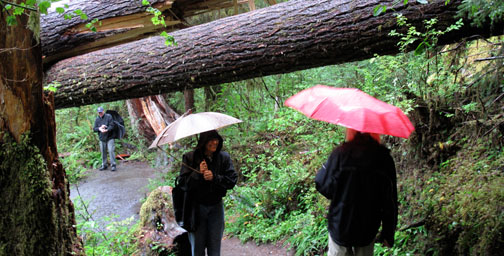 |
||
Hoh Rain Forest Trail |
||
We figured the best way to make some cool discoveries was to drive the byway, stop whenever the muse struck and just ignore any daily schedule. Of course, since we were headed into the rain forest during the rainy season, we took along plenty of waterproof gear including umbrellas and hooded jackets. We opted to drive counterclockwise around the wild, wooly and rainy loop, most of it on Highway 101. Although the official Scenic Byway begins in Olympia, we picked up the loop at Port Townsend, a town second only to San Francisco in its abundance of Victorian gingerbread houses. Many thrive as bed and breakfasts; others open for tours in spring and fall. Check local papers for schedules. |
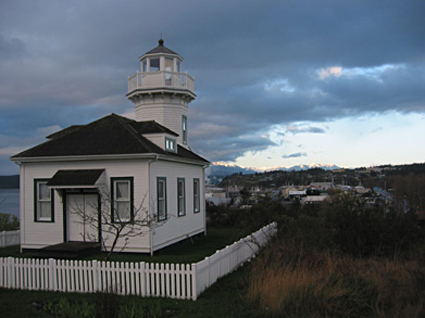 |
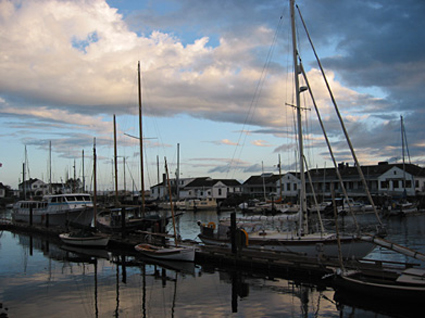 |
|||
Port Townsend lighthouse LEVYsheckler |
Port Townsend marina LEVYsheckler |
On the bluffs above Port Townsend sits Fort Worden State Park, originally built to protect Navy bases and shipping ports in WW II, now a central community location for many specialty schools, conferences and symposia. A drive down Officer’s Row there affords a sense of the grand scale of the fort. Parts of the film An Officer and a Gentleman were filmed here. We continued west through Sequim, the so-called “banana belt” of the Pacific Northwest because it’s in the rain shadow of the Olympic Mountains and gets much less rain than surrounding areas. A five-mile side trip north to the Dungeness Spit National Wildlife Refuge and a county park took us to the longest spit in the nation, which is growing longer each year by 15 feet. The spit, used by about twenty-five thousand shore birds, thirty thousand migrating ducks and geese, and up to five hundred harbor seals, shelters a bay with one of Puget Sound’s last undisturbed eelgrass beds. Black brant geese depend on this eelgrass for food. On to Port Angeles, the deep harbor protected by the three-mile-long Ediz Hook sand spit, a natural jetty with a path, road and picnic tables—a great spot to stop for lunch out of the cooler. It has the best views of the peninsula so get out your cameras. |
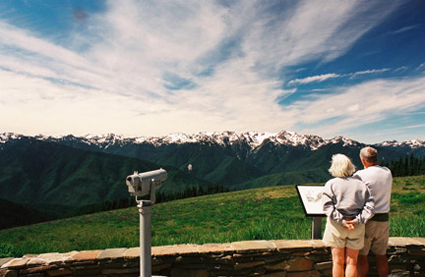 |
||
Hurricane Ridge LEVYsheckler |
There’s another great view from Hurricane Ridge, 5,329 feet above Port Angeles, down into the Olympic National Park. Follow the signs from US 101 downtown or go south on Race Street, which becomes Hurricane Ridge Road. The visitor center has park information and sells sandwiches, light meals, curios and gifts. The small downhill ski area operates on weekends and holidays only, with a poma lift and two rope tows. Snowshoe on the weekends with a forest ranger. www.olympicpeninsula.org/ |
 |
 |
|||
Glines Canyon Dam |
Glines Canyon Dam |
|||
 |
 |
|||
Glines Canyon Dam |
Glines Canyon Dam |
|||
Back on US 101, we decided to take another short side trip to check out the site of the largest dam removals in U.S. history, the Elwha and Glines Canyon dams on the Elwah River. The process, which begins summer of 2011, will free the river and allow thousands of salmon to return to over 70 miles of rivers and streams. When the dams were built in the early 1900s, they played a vital role in the development of the area but provided no way for the salmon to reach upstream habitat. Removing the dams will open pathways and promises to restore salmon habitat. For more information, visit http://www.nps.gov/olym/index.htm. |
||
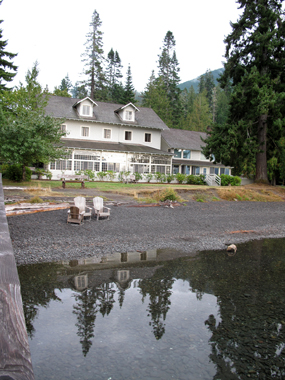 |
 |
|||
Lake Crescent Lodge |
Lake Crescent rental kayaks |
|||
 |
 |
|||
Lake Crescent pier |
Lake Crescent Lodge cabins |
|||
| Again, back on Highway 101, as we drove along the spectacular shoreline of Lake Crescent, we saw signs for one of the Big Four and stopped for a short visit to Lake Crescent Lodge. Built in 1916, this historic lodge whispers elegance in the wilderness with its antique-furnished lobby, roaring fire-filled stone fireplace, cozy sun porch and bracing dock and beach below the green expanse of lawn. The Lodge has quite a pedigree in the dining and luxe departments with a swell variety of accommodations. Besides, it’s central to lake and forest tours as well as hiking and biking and you don’t have to wear a gown or a tux to dinner! Closed for the winter, it re-opens May 5, 2011. www.olympicnationalparks.com/accommodations/lake-crescent-resort. |
 |
 |
|||
Sol Duc Valley Hot Spring Resort |
Sol Duc Valley Hot Spring pools |
We turned off 101 towards Sol Duc Valley Hot Spring Resort to check in for our first night at a Big Four. The smell of sulfur wafted through the air as we walked into the lodge. The natural mineral waters that give the resort its name permeate the premises with the odor, but also promise a long, hot and relaxing soak in the four outdoor, hot spring-fed pools behind the lodge. There is also a full-sized, freshwater swimming pool.
 |
|
|||
Cabin units at the Sol Duc Valley Hot Spring Resort |
Picnic dinner |
| We got situated in our small, rustic kitchenette cabin room, which had basic furnishings, dim light and a galley kitchen with stove and fridge. Since the dining room at the lodge was closed by the time we arrived, we fixed a simple but splendid dinner repast of soup, cheese and good bread out of our cooler. There is a small convenience store and a gift shop at the lodge next to the restaurant, but no communal gathering lobby for guests. There is also no TV or Internet access, so bring a good book and maybe a 300-watt light bulb for reading in your cabin. | ||
 |
 |
Sol Duc Valley Hot Spring pools |
||
| The next morning, mist covered the hot springs pools but certainly didn’t dampen enthusiasm for folks both staying at the lodge and driving in from nearby campgrounds to use the springs. Entrance to the pools is open to the public for a fee as well as to guests. There seemed to be many more spa-seekers who were not guests of the lodge. Three vans of freshman UDub students who were on a Pacific Northwest/Olympic Peninsula familiarization trip before starting classes last fall pulled in to experience the hot springs with an abundance of enthusiasm. | ||
 |
 |
Hike through the drizzling rain forest to Sol Duc Falls |
||
 |
 |
|||
Trail to Sol Duc Falls |
Sol Duc Falls |
|||
After an early morning soak in all four pools and a quick swim, we took what seemed a magical three-mile hike through the drizzling rain forest to Sol Duc Falls, a gorgeous spot in the middle of dripping firs next to the roaring Soleduck River. It’s a rocky and root-riddled route, (watch your step) but has only a 200-foot elevation gain and is an easy hike for agile families. www.olympicnationalparks.com/accommodations/sol-duc-hot-springs-resort. As we continued the rain-soaked drive along101, we approached Forks, the historically untamed logging town that, years back, hit hard times with the bust of the timber business, But, due to it’s recent celebrity status because of the splash of the Twilight movies being shot there, Forks has seen a renewed boom in tourist traffic and business. Hoping to attract passing travelers, a motel on the edge of town boasted this sign: Edward Cullen Didn’t Sleep Here. Cullen, of course, is the vegetarian vampire in the Twilight series. A local burger joint had New Moon posters in the window alongside Home of the Bella Burger and Twilight Punch banners. Seemed that every business in the small town had signs welcoming Twilight Fans Here! The best sign we saw: Welcome to Forks, the Twilight Capital of the World. Where Vampires and Werewolves are Welcome and Shirts are Optional. The Twilight wrap we bought for lunch at the local Safeway deli was pretty darned good. But we passed up the Twilight firewood. The next seven miles to the Hoh Rain Forest turn-off follows a level course through the inland Olympic Experimental State Forest. We turned left onto the Upper Hoh Road and continued 18 miles to the visitor’s center. |
||
 |
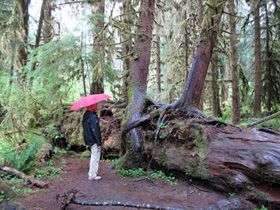 |
 |
The Hoh Rain Forest is the only coniferous one in the world and is well worth the effort to visit, especially in the rain. Take a brolly, wear some boots and stroll through an amazing and rare temperate wonderland. From the Hoh Ranger Station and visitor center venture out on the Hall of Mosses Trail, a 0.75-mile loop. It’s easy-going and self-guided, but can take a few hours if you dawdle in wonder at the cathedral-like settings. |
||
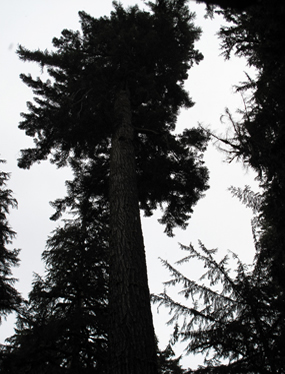 |
 |
 |
The 600-year-old Sitka spruce trees grow 200 feet or more, dwarfing the surrounding Douglas fir and Western Hemlock. We wound our wet way alongside club moss draping from branches like heavy lace, which surrounded open expanses resembling the Disneyland-like vistas. Guided walks are also available. http://www.nps.gov/olym/planyourvisit/visiting-the-hoh.htm. |
||
| We were soggy but determined to make it to Lake Quinault Lodge before dark, so we bypassed Ruby Beach and made a quick pit stop at Kalaloch Lodge for some reminiscing, hot coffee, spectacular views and pictures and a must-visit to the gift shop. |
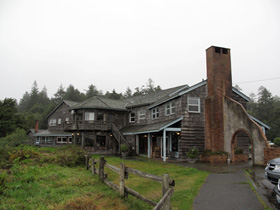 |
 |
 |
||||
Kalaloch Lodge |
Author Lynn Rosen above the beach |
Kalaloch Lodge Cabins |
| The Lodge, perched high on a bluff, above stretches of sandy Pacific beach, offers rustic accommodations available with cozy fireplaces and ocean views. As part of the Olympic Coast National Marine Sanctuary, Kalaloch is the permanently protected home to puffins, sea otters and the largest populations of bald eagles in the lower 48 states. With its nearby hiking trails, bicycling and whale watching adventures, Kalaloch is a great stop on a Pacific Coast Scenic Byway tour. It is open year-round. http://www.olympicnationalparks.com/accommodations/lake-quinault-lodge.aspx. | ||
 |
 |
|||
Lake Quinault Lodge rental sailboats |
Lake Quinault Lodge lobby in the evening |
| After turning inland and just a few miles off 101 on South Shore Road, however well after dark, we finally arrived at Lake Quinault Lodge, on the south shore of Lake Quinault. A warm, cozy and elegant lobby greeted us with a roaring fire in the huge fireplace with guests comfy in armchairs and on casual couches, playing chess, reading books, checking their email. Our spacious luxe room overlooked the lake and sported a gas fireplace, a huge, high bed with a multitude of pillows and was just down the hall from the lobby where we could get on the Internet. After a few days away from civilization, it was comforting to know we could connect with friends, family and business. | ||
|
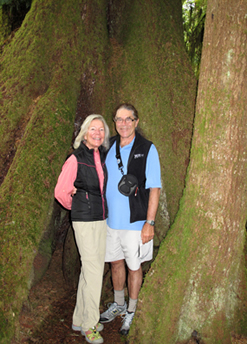 |
|
The next morning at 10, we met a guide in the lobby and boarded a small van with another couple who were staying at the lodge for a three hour, 1.6 mile guided hike around the lake. The Lodge, which is privately owned, provides this guide service for a $25/adult, $10/kids 7-12, free/kids 0-6. |
||
 |
|
 |
Our guide, Sandra Miller, an employee of the Lodge and not a forest ranger, was extremely well informed about the area. She shared lore and history as we drove and chatted and made significant stops at points of interest all around the lake. We took short hikes into the surrounding rain forest and made photo stops at different points of interest. This interpretive tour was so crammed with fascinating information; the tour would make a whole story itself. |
||
The famous Roosevelt Dining Room, named for FDR, who visited in 1937, overlooks the lake and specializes in Pacific Northwest cuisine and fresh seafood. (The Roosevelt Elk on the peninsula are named for Teddy Roosevelt.) The gift shop next to the lobby has many treasures for personal memories and for gifting. We reluctantly checked out the following morning, set out on US Highway 101 and headed back to civilization with promises to make time to visit the Olympic Peninsula and the Great Lodges again next season. http://www.olympicnationalparks.com/stay/lodging.aspx IF YOU GO For more information on the following sites and properties, visit the websites below. The Four Legendary Lodges on the Olympic Peninsula http://www.olympicnationalparks.com/stay/lodging.aspx. The Olympic Peninsula www.olympicpeninsula.org/ Elwha and Glines Canyon Dams http://www.nps.gov/olym/index.htm. Lake Crescent Lodge www.olympicnationalparks.com/accommodations/lake-crescent-resort. Sol Duc Hot Springs Lodge www.olympicnationalparks.com/accommodations/sol-duc-hot-springs-resort. Hoh Rain Forest http://www.nps.gov/olym/planyourvisit/visiting-the-hoh.htm Kalaloch Lodge www.olympicnationalparks.com/accommodations/kalaloch-lodge. Lake Quinault Lodge http://www.olympicnationalparks.com/accommodations/lake-quinault-lodge.aspx |
| Lynn Rosen can be reached at lynrosen@aol.com |